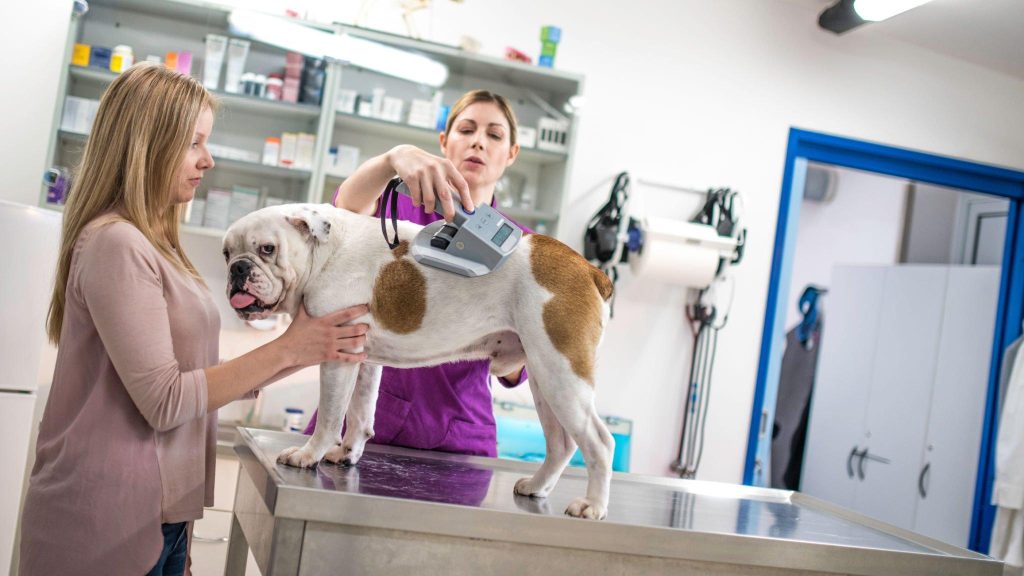Female English Bulldog Breeding Age – All You Need To Know
English Bulldogs, with their distinctive appearance and loyal nature, have captured the hearts of many. Yet, diving into the world of breeding these lovable creatures requires knowledge, especially about the right breeding age.
Choosing the correct breeding age isn’t just about producing the next adorable litter; it’s vital for the health and well-being of both the mother and the puppies. Breeding too early or too late can lead to complications that no pet lover wants to encounter.
In this guide, we’ll delve into understanding the optimal breeding age for female English Bulldogs. With a blend of scientific insights and expert recommendations, we aim to guide potential breeders on a responsible and informed journey. Let’s get started!
Overview of English Bulldog’s Lifecycle
Every pet lover knows that dogs, much like humans, go through various stages in their lives. The English Bulldog is no exception.

Recognizing these stages helps in understanding their needs, behaviors, and most importantly, the best breeding age.
Puppy Stage (0-12 months)
The adorable puppy phase! This is the time when English Bulldogs are playful, curious, and full of energy. They’re growing rapidly, both in size and in learning about the world around them. While they might seem grown-up by the end of this stage, they’re still far from being ready for breeding.
Adolescent Stage (1-3 years)
Welcome to the teen years of the English Bulldog. During this period, Bulldogs might display a more rebellious streak, testing boundaries just like human teenagers. Although they reach physical maturity around this age, their emotional maturity is still developing.
Adult Stage (3-8 years)
This is the prime of an English Bulldog’s life. They’re typically more settled, calmer, and make excellent companions. Most breeders consider the early part of this stage as the optimal breeding age, balancing both physical and emotional readiness.
Senior Stage (8 years onward)
As senior citizens in the dog world, older English Bulldogs often become more relaxed and may have a few health issues. Breeding is not recommended at this stage, as it poses health risks to both the mother and the puppies.
Understanding the lifecycle of an English Bulldog isn’t just about knowing when to breed. It’s about appreciating every moment and every stage of their lives, ensuring they’re given the best care and love they deserve.
When is a Female English Bulldog Physically Ready for Breeding?
Bulldog enthusiasts often wonder about the right moment to breed their beloved pets. While timing is key, it’s crucial to first understand when a female English Bulldog is physically ready to carry and nurture a litter.
Physical maturity typically arrives before emotional maturity. By the age of 2, many female English Bulldogs have developed the physical attributes necessary for breeding. This doesn’t mean they should be bred immediately, but it’s a sign they’re getting closer.
But how do you spot physical readiness? A few indicators include regular heat cycles, a well-developed body (not the lean puppy-like physique), and overall good health. If she’s experiencing consistent and regular heat cycles, it’s an essential sign of reproductive maturity. However, these signs alone don’t give the green light for breeding.
It’s essential to note that just because a bulldog is physically mature doesn’t mean she’s ready for the responsibilities of motherhood. Just like in humans, early pregnancies can be tough on a young body. It’s always a good idea to consult with a veterinarian to get their perspective on when it’s best to breed.
In conclusion, while age provides a rough guideline, the individual health and physical readiness of the female English Bulldog are paramount. Breeding should be approached with care, consideration, and expert advice, ensuring the well-being of both the mother and her future puppies.
Importance of Waiting for Emotional and Behavioral Maturity
While physical readiness might seem like the go-ahead for breeding, there’s another crucial factor often overlooked: emotional and behavioral maturity. Just like humans, English Bulldogs need to be emotionally mature before taking on the role of parenthood.
Breeding a Bulldog before she’s emotionally ready can lead to challenges. An emotionally immature mother might struggle with maternal instincts, potentially neglecting her puppies or becoming overly stressed. These behaviors aren’t indicative of a bad dog but rather a dog not yet ready for the demands of motherhood.
What signs show emotional maturity? A mature Bulldog is often calmer, less reactive, and more confident in unfamiliar situations. They’ve outgrown the playful recklessness of puppyhood and the defiant nature of their adolescent phase. These are dogs that have found their place in the pack and understand their role.
However, there’s no strict timeline for emotional development. Some Bulldogs might reach this stage by 3 years, while others might need a bit more time. It’s about observing and understanding individual personalities rather than just ticking off days on a calendar.
In essence, ensuring a female English Bulldog is emotionally mature before breeding leads to a smoother, safer experience for the mother and her puppies. So, when considering breeding, remember to think with both your heart and head, prioritizing the well-being of the Bulldog and her future family.
Health Considerations Before Breeding
When thinking about breeding, many focus on age and behavior. However, health is the cornerstone. Before breeding your female English Bulldog, her health should be a top priority, ensuring a safe pregnancy and healthy pups.

Firstly, consider genetic concerns. English Bulldogs have some known hereditary health issues. It’s wise to get your Bulldog tested for common genetic diseases. This not only protects the puppies but helps improve the breed’s overall health.
Regular vet check-ups are invaluable. A thorough examination can detect underlying conditions like hip dysplasia, respiratory problems, or heart issues. These conditions can be exacerbated by pregnancy, posing risks to both the mother and her pups.
Moreover, a fit and healthy Bulldog is more likely to have a smoother pregnancy and delivery. Ensure she’s on a balanced diet, gets regular exercise, and is neither overweight nor underweight. Proper weight management is vital, as obesity can complicate both conception and delivery.
In conclusion, before you even think about breeding, prioritize your English Bulldog’s health. A healthy mother gives her puppies the best start in life. Remember, breeding should always be a thoughtful decision, backed by knowledge and the guidance of veterinary professionals.
How Often Can a Female English Bulldog Be Bred?
The frequency of breeding is a common question among English Bulldog owners. While the prospect of having adorable pups regularly is tempting, it’s vital to understand the recommended limits for a female’s well-being.
Just like a French Bulldog, generally, it’s advised to wait for a English Bulldog to be at least two years old before her first breeding. This ensures she’s physically mature and emotionally prepared for motherhood.
After the first litter, it’s crucial to give her body time to recover. Ideally, a female Bulldog should only produce a litter once every 18 to 24 months. This allows her to regain strength, ensuring she’s fit and ready for the next breeding cycle.
Overbreeding, or having too many litters in a short span, can strain a Bulldog’s health. Continuous breeding can lead to nutritional deficiencies, increased vulnerability to illnesses, and even shortened lifespan.
In essence, while Bulldogs are capable of producing multiple litters, it’s a matter of quality over quantity. Prioritize her health and well-being, and consult with a vet to determine the best breeding schedule. After all, a happy, healthy Bulldog mom means happy, healthy pups.
Ethical Considerations in Breeding
Breeding is more than just producing litters; it carries ethical responsibilities. For every English Bulldog breeder, prioritizing the breed’s health and welfare is essential.
One major concern is breeding purely for aesthetics. While Bulldogs with specific looks might fetch higher prices, breeding solely for appearance can perpetuate health problems. It’s vital to balance between desirable traits and the health of the breed.
Next, consider the responsibility of care. Every Bulldog puppy brought into this world deserves a loving home. Breeders should ensure potential pet owners are well-informed and equipped to care for their new furry family member.
Overpopulation is another ethical issue. With many dogs in shelters awaiting homes, breeders should be mindful of their litters’ numbers and focus on quality, health, and homes over quantity.
In conclusion, ethical breeding goes beyond biology. It’s a commitment to the betterment and love of the English Bulldog breed. Breeders should always act with knowledge, compassion, and the bigger picture in mind, championing the best for these beloved dogs.
Frequently Asked Questions (FAQs)
1. At what age is a female English Bulldog most fertile?
While physical maturity can start as early as 2 years, female English Bulldogs are often most fertile between the ages of 3 to 5. Always consult with a vet to determine the best age for breeding your individual dog.
2. How many litters can a female English Bulldog safely have in her lifetime?
The recommended number varies, but most experts suggest no more than three litters in a lifetime, ensuring ample rest and recovery between each.
3. Are there health tests I should conduct before breeding my Bulldog?
Absolutely! Before breeding, Bulldogs should be screened for genetic disorders, hip dysplasia, respiratory issues, and other prevalent health concerns. Regular check-ups with a veterinarian are also essential.
4. How can I ensure the well-being of my Bulldog during pregnancy?
A balanced diet, regular but gentle exercise, and frequent vet visits will ensure your Bulldog remains healthy during pregnancy. Also, be sure to provide a comfortable space for her to rest.
5. What are the common signs that my Bulldog is ready for breeding?
Physical signs include regular heat cycles and a well-developed physique. Emotional signs are often seen as calmness, confidence, and a settled demeanor. Always combine these observations with expert advice before making a decision.
Conclusion
Breeding English Bulldogs is a rewarding journey, but one that comes with immense responsibility. From understanding their physical and emotional maturity to prioritizing their health, every decision should center around the well-being of the dog. By adopting an informed and ethical approach, breeders can ensure the longevity and health of this beloved breed.
If you’re considering stepping into the world of breeding, remember that it’s a blend of science, art, and heart. Consult regularly with veterinary professionals, stay updated on the latest research, and most importantly, always act with the best interests of the English Bulldog in mind. Their future is, after all, in our hands.

